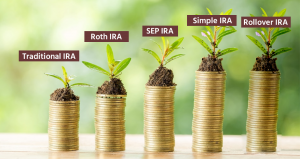What Is an IRA in Simple Terms?
Published Date: September 29, 2022

So what is an IRA? An IRA, Individual Retirement Account or Individual Retirement Arrangement is a savings account that allows people to invest money to generate retirement income.
In addition to being the most popular tax-advantaged retirement savings vehicle available currently, it offers a low-risk-low return alternative for conservative investors.
Specifically, an IRA is a qualified personal savings account that allows individuals of any age and income level to invest in mutual funds, stocks, bonds, and precious metals like gold.
What Is the Primary Purpose of an IRA?

The primary purpose of a traditional IRA is to provide income with tax benefits to its account holders during their retirement years. The invested money will grow tax-deferred, meaning you will pay no taxes upon contribution like with 401K or similar plans.
IRAs offer the opportunity to make investments of a significant portion of your savings while limiting your risk. With traditional IRAs, you will still own all the stocks, bonds, and other assets you purchase with your money. As such, IRAs offer a wide variety of contributing options with low fees involved.
Investing in stocks allows you to own shares in publicly traded companies. The lowest-risk investment you can make is a bond, which offers money to investors and, often, the government.
The Federal Deposit Insurance Corporation (FDIC) protects all your traditional IRA investments. Your deposits get protected up to a specific limit per account type. The maximum FDIC insurance amount is $250,000, which applies to all accounts held at the same institution by an individual, regardless of the number of accounts.
As we’ll discuss, an IRA is often an alternative to a 401K for individuals who don’t have access to one, such as those who are self-employed.
Is an IRA the Same as a 401K?

While an IRA and a 401k are retirement accounts, they are two very different types of plans. The difference between the two is that, in a 401k plan, the employer contributes to the employees’ accounts, whereas when you contribute to an IRA, you do it yourself.
Employees save a portion of their salary on a pre-tax basis, which means they do not pay taxes on the income until they withdraw their funds after retirement. Although one can contribute to IRAs and 401ks, people cannot use their IRAs as loan collateral.
401k contributions are pre-tax, meaning that your investment funds will be deducted from your taxable income, thus lowering your total tax liability. An IRA gets funded with after-tax money. A 401k cuts down on current taxes, while an IRA has lower costs and higher returns.
403b plans are similar to 401k plans, but these are for employees of public schools, non-profit organizations, and government agencies. The main difference between a 403b and a 401k plan is that some sections of the Internal Revenue Code have different rules for the contributions one can make.
What Are the Different Types of IRA Accounts?

The types of IRAs differ in taxation and the laws regarding their use. The accounts are subject to RMDs (Required Minimum Distributions) that the IRS requires you to take from your IRA once you reach age 72, apart from Roth IRA.
Married tax filers can jointly invest within contribution limits subject to modified adjusted gross income (MAGI) requirements. Let’s look at five popular types of IRA accounts.
Traditional IRA
Any contributions to a traditional IRA, including earnings and withdrawals, are tax-deferred until withdrawn. No taxes are paid on your money until you start drawing on it in retirement.
All distributions, including any investment gains, are subject to tax at your ordinary income tax rate when withdrawn.
Contributions are tax-deductible, and earnings grow tax deferred. Earnings on distributions before age 59 1/2 will get taxed as regular income, and if taken before age 59 1/2, there is also a 10% penalty. On the plus side, withdrawing contributions are always free of taxation and liability.
Roth IRA
Contributions to a Roth IRA are not tax-deductible and thus made with after-tax dollars. However, all earnings and withdrawals from the account, including investment gains, are tax-free in retirement.
A Roth IRA is a type of individual retirement account opened on an after-tax basis, meaning the contribution money comes from your earnings and has already gotten taxed. A Roth IRA offers investors tax-free earnings growth and withdrawal eligibility.
SEP IRA
An SEP IRA (Simplified Employee Pension) is a traditional plan set up by an employer to benefit employees. The pension benefits self-employed individuals, small business owners, and independent contractors. Employers may contribute to SEP IRAs set up for their employees but not to an IRA opened at a bank.
Simple IRA
A Simple IRA is meant for small businesses of 100 employees or fewer. “Simple” isn’t because it’s easier: it’s an acronym. It stands for (S)avings (I)ncentive (M)atch (PL)an for (E)mployees. It was intended to be used for startups and small businesses who don’t have an alternate retirement plan for employees.
Employers must provide at least 2% of an employee’s income (nonelective), or match up to 3% for contributions. Regardless of the level of contribution, the employee is 100% vested and retains absolute ownership of the account.
Unlike the traditional IRA, simple IRAs offer no tax-deferral benefits. The amount contributed is included in taxable income.
Rollover IRA
Rollover IRAs allow investors to transfer their existing 401k to an IRA with another financial institution, which isn’t considered a taxable event.
This type of IRA is generally easy to establish and maintain, allowing individuals to take advantage of an account that does not have the same fees or restrictions as a 401K. There are no income limits for rollover IRAs, but you can only complete one rollover per year.
Comparing IRA Investment Options
Let’s take a closer look at some of the different IRA investment choices you have.
|
IRA Type |
Traditional IRA |
Roth IRA |
SEP IRA |
Simple IRA |
Rollover IRA |
|
Eligibility |
Individual taxpayers, couples |
Individual taxpayers, couples (subject to MAGI limitations) |
Self-employed people and small business owners |
Self-employed individuals and small business owners |
401K and IRA owners |
|
Income Limits |
$109,000 to $129,000 for couples, $68,000 to $78,000 for single taxpayers |
$129,000 to $144,000 for single filers, $204,000 to $214,000 for couples |
At least $650 in the form of employer compensation |
An employee must expect to receive at least $5,000 |
Account balances in your preceding IRA or 401k plan |
|
Contribution Limits |
$6000, $7,000 if 50 years or older due to catch-up contribution |
$6000, $7,000 if age 50 or more |
Not more than the lesser of 25% compensation, $61,000 |
$14,000, $17,000 if 50 years or older |
Not more than one rollover from the same IRA within one year |
|
Deduction Limits |
Depends on your income and filing status |
Depends on filing status |
No filing requirements for the employer |
The employer has no filing requirements |
The IRS requires 20% of distributions to be withheld for federal tax, but you can choose to have no tax withheld |
|
Distributions & RMDs |
Subject to RMD from age 72 |
Roth account heirs are subject to RMD |
Subject to RMD if 72 years or older |
Subject for individuals aged 72 and more |
Subject to individuals aged 72 and more |
|
Withdrawals |
10% penalty when you make a withdrawal before age 59 1/2 |
Withdraw without incurring income tax when you retire |
10% penalty when for withdrawals before age 59 1/2 |
Withdrawals are subject to a 10% additional tax if under age 59-1/2 |
Payments will get taxed when you fail to roll over within 60 days |
|
Tax Breaks |
Contributions are tax-deferred during retirement |
Contributions are non-tax deductible, qualified distributions are tax-free |
Contributions are tax-deferred in retirement |
Tax-deferred contributions during retirement |
Your contributions grow tax-deferred |
How Does an IRA Work?

An investor can choose to contribute either pre-tax or after-tax dollars. With a traditional IRA, investors contribute after-tax dollars and make no pretax contributions, that is, no deduction for the contribution.
When you retire, your investments in retirement accounts will be taxed based on the current tax brackets. If you have a traditional IRA or Roth IRA, you can use your principal and investment gains to fund a portion of your retirement plan or simply take it out as cash and pay taxes on it as ordinary income.
How to Setup an IRA?

The first step is choosing where you want to open your IRA account. Financial institutions like banks, brokerage firms, or custodians like Fidelity Investments or Vanguard are the most common places.
The easiest way is by setting up a Direct Deposit from your paycheck. Direct pay makes it quick and easy because all your money goes straight into the IRA account.
Most financial institutions offer IRAs through either a Tax-Free Savings Account (TFSA) or taxable account. To open an IRA with your bank or brokerage firm, you must provide proof that you have earned income from somewhere else.
You are then supposed to select an IRA account from the different types of IRA accounts available. As mentioned, some give you a tax-free withdrawal when you retire, while others now offer a valuable tax deduction.
Each type of account has pros and cons, so research the best fit for you. When opening the account, you’ll need your name, address, social security number, and copies of documents like proof of income or driver’s license.
When opening an account, the administrator of the IRA will determine which type of IRA is suitable for you. For example, if you are a pensioner and are making annual contributions, it is recommended that you hold a traditional IRA.
After IRA setup, you can start depositing funds. You can do this via checking, electronic payment, or directly transferring money from your bank account. Remember that you can’t give more than the IRS’ annual limit. After funding your account, you can proceed to invest through the diverse investment options.
How Much Money Does It Take To Start an IRA?

The contribution limit for Traditional and Roth IRAs is $6,000. If you’re 50 years or older, the IRS will allow you to contribute an extra $1,000 per year, making your yearly limit $7,000.
You can make IRA contributions any time between the beginning of the year and the mid-April deadline for a tax year. You can make contributions periodically based on your financial capacity.
It’s best to contribute your total investment amount at the start of the year if you have the money to give your investment the most extensive compound interest rate. It’s hard for many people to come up with $6,000 all at once. In this case, it’s better to set up a contribution schedule.
Typically, you can arrange automatic transfers from your bank account to your IRA account, for instance, monthly, when you receive your paychecks. By setting up periodic contributions, you can make those $6,000 more manageable and provide dollar-cost averaging (DCA).</a >
When Can I Withdraw From an IRA?

You can withdraw from an IRA at any time, but you will face penalties if you withdraw early. You’ll be subject to gross income tax, typically with an additional 10% tax penalty for removing funds early. You have to wait until you are 59½ to withdraw from an IRA without being penalized.
When an investor withdraws money from an IRA, the withdrawal will get taxed at current tax rates. The penalty only applies to contributions earned on your account, not the principal. In this case, the penalty is a flat fee. If you are over 59½ years old, you can take out your money without any penalties or taxes.
However, IRAs offer exceptions that allow for early withdrawals without penalty, such as funds from a qualified disability expense, taking money for unreimbursed medical expenses, or first-time real estate endeavors.
Is an IRA a Good Investment?

If you don’t have a 401K with your employer, or you want to rollover your funds into something more competitive, an IRA is an excellent investment opportunity. With an IRA, you can save for retirement and take advantage of the tax benefits that come with this type of investment vehicle.
Invest your money in an IRA with built-in investment features to help you achieve better returns, maximize growth and minimize taxes. Because IRAs are federally funded and managed, they tend to be much more stable than a stock market and offer investors significant savings opportunities.
Frequently Asked Questions (FAQs)
How Does an IRA Make Money?
The investment earnings from your IRA will be either from stocks, bonds, mutual funds, or some other type of investment. It depends on which kind of retirement plan you choose to open.
How Much Do IRAs Grow?
Your income from an IRA depends on your investment strategy and the rate of return.
Is It Better To Have an IRA or Savings Account?
With an IRA, you automatically save for retirement and can invest in diverse investments for the future. You can’t do this with a savings account with investment options like a Certificate of Deposit (CD).
Are Individual Retirement Accounts FDIC Insured?
Yes, IRA accounts are FDIC-insured. The FDIC is a government agency that safeguards your deposits in banking institutions up to $250,000 per depositor. An investor’s original principal is always 100% guaranteed by the FDIC, no matter what happens in the financial institution.
Do You Have To Contribute to a Traditional IRA Every Year?
No, you can save for retirement in a traditional IRA without being required to contribute yearly.
Can I Lose My Money in an IRA?
Every investment is subject to risks, including an IRA. In a worst case scenario, you could potentially lose money. However, with the right management, you can mitigate those risks and increase your chances for gains with measures like diversification.
Do Beneficiaries Pay Tax on IRA Inheritance?
No, beneficiaries do not pay a tax on an IRA inheritance. IRAs are tax-free to the heirs, as are retirement funds from other assets like stocks and bonds. Your beneficiary will receive the property tax-free and be exempt from state inheritance tax.
Does IRA Income Affect Social Security?
An IRA does not affect your income as the Social Security Administration does not consider your IRA distributions when calculating your benefits.




